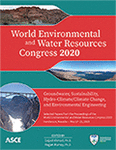World Environmental and Water Resources Congress 2020
Attributing Natural Gas Production to Natural Gas Users: A Geospatial Approach
Publication: World Environmental and Water Resources Congress 2020: Groundwater, Sustainability, Hydro-Climate/Climate Change, and Environmental Engineering
ABSTRACT
Natural gas is often perceived as a commodity fuel with limited variability, largely due to extensive standardization of pipeline-quality natural gas. Once natural gas is processed and entered into the transmission and distribution system, it is nearly pure methane with limited tolerance for impurities. Upstream of the transmission and distribution system, however, natural gas characteristics vary substantially. For example, production basins have highly variable carbon dioxide (CO2) and other non-methane (CH4) content. Extraction and processing practices vary as well. One of the most significant environmental characteristics of natural gas is its greenhouse gas (GHG) intensity, which has increasingly been highlighted as shale-based production continues and as attention to the requirements for a fully decarbonized energy system grows. It is well established that methane leakage from natural gas systems is higher than long understood, largely due to variation in leakage during the production stage. Such leakage varies by basin. Similarly, the CO2 content of raw gas varies by basin. This work uses recent research findings from some of the U.S.’ primary natural gas production basins, in addition to information about the location of natural gas infrastructure, to establish methods to determine first-order estimates of the GHG of natural gas being used around the United States. Although natural gas is a commodity product, the environmental footprint of a given unit of natural gas can vary substantially based on its origin and infrastructural needs. Using existing data, we outline methods to quantify where natural gas from each basin is ultimately being consumed.
Get full access to this article
View all available purchase options and get full access to this chapter.
REFERENCES
Alvarez, R. A., Zavala-Araiza, D., Lyon, D. R., Allen, D. T., Barkley, Z. R., Brandt, A. R., … Hamburg, S. P. (2018). Assessment of methane emissions from the U.S. oil and gas supply chain. Science, 361(6398), 186–188. https://doi.org/10.1126/science.aar7204
Caulton, D. R., Shepson, P. B., Santoro, R. L., Sparks, J. P., Howarth, R. W., Ingraffea, A. R., … Miller, B. R. (2014). Toward a better understanding and quantification of methane emissions from shale gas development. Proceedings of the National Academy of Sciences of the United States of America, 111(17), 6237–6242.
Energy Information Administration. (2019). Annual Energy Outlook 2019 <https://www.eia.gov/outlooks/aeo/data/browser/#/?id=2-AEO2019®ion=1-0&cases=ref2019&start=2017&end=2050&f=A&linechart=ref2019-d111618a.3-2-AEO2019.1-0~~ref2019-d111618a.90-2-AEO2019.1-0&map=&ctype=linechart&sourcekey=0> (accessed 26 December 2019).
Energy Information Administration. (2019a). Glossary <https://www.eia.gov/tools/glossary/index.php?id=A> (accessed 6 December 2019).
Energy Information Administration. (2019b). Layer Information for Interactive State Maps <https://www.eia.gov/maps/layer_info-m.php> (accessed 6 December 2019).
Energy Information Administration. (2019c). Natural Gas Data <https://www.eia.gov/naturalgas/data.php#summary> (accessed 6 December 2019).
Energy Information Administration. (2019d). Natural Gas Explained, <https://www.eia.gov/energyexplained/natural-gas/> (accessed 6 December 2019).
Energy Information Administration. (2019e). U.S. Natural Gas Processing Plant Capacity and Throughput have Increased in Recent Years, <https://www.eia.gov/todayinenergy/detail.php?id=38592> (accessed 21 December 2019).
Grubert, E. A., & Brandt, A. R. (2019). Three considerations for modeling natural gas system methane emissions in life cycle assessment. Journal of Cleaner Production, 222, 760–767.
Intergovernmental Panel on Climate Change. (2018). Anthropogenic and Natural Radiative Forcing, <https://www.ipcc.ch/site/assets/uploads/2018/02/WG1AR5_Chapter08_FINAL.pdf> (accessed 21 December 2019).
Konschnik, K. E., & Boling, M. K. (2014). Shale Gas Development: A Smart Regulation Framework. Environmental Science & Technology, 48(15), 8404–8416.
Omara, M., Zimmerman, N., Sullivan, M. R., Li, X., Ellis, A., Cesa, R., … Robinson, A. L. (2018). Methane Emissions from Natural Gas Production Sites in the United States: Data Synthesis and National Estimate. Environmental Science & Technology, 52(21), 12915–12925.
Ravikumar, A. P., & Brandt, A. R. (2017). Designing better methane mitigation policies: The challenge of distributed small sources in the natural gas sector. Environmental Research Letters, 12(4).
Saunois, M., Jackson, R. B., Bousquet, P., Poulter, B., & Canadell, J. G. (2016, December 12). The growing role of methane in anthropogenic climate change. Environmental Research Letters, Vol. 11.
Stephenson, T., Valle, J. E., & Riera-Palou, X. (2011). Modeling the relative GHG emissions of conventional and shale gas production. Environmental Science and Technology, 45(24), 10757–10764.
U.S. Department of Energy. (2019). Natural Gas Flaring and Venting: State and Federal Regulatory Overview, Trends, and Impacts, <https://www.energy.gov/sites/prod/files/2019/08/f65/Natural%20Gas%20Flaring%20and%20Venting%20Report.pdf> (accessed 6 December 2019).
Information & Authors
Information
Published In
World Environmental and Water Resources Congress 2020: Groundwater, Sustainability, Hydro-Climate/Climate Change, and Environmental Engineering
Pages: 302 - 313
Editors: Sajjad Ahmad, Ph.D., and Regan Murray, Ph.D.
ISBN (Online): 978-0-7844-8296-4
Copyright
© 2020 American Society of Civil Engineers.
History
Published online: May 14, 2020
Published in print: May 14, 2020
Authors
Metrics & Citations
Metrics
Citations
Download citation
If you have the appropriate software installed, you can download article citation data to the citation manager of your choice. Simply select your manager software from the list below and click Download.
